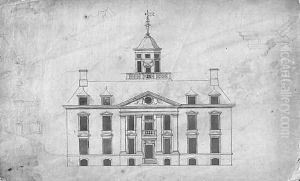Robert Hooke Paintings
Robert Hooke was a pivotal figure in the scientific revolution, whose contributions spanned the fields of physics, astronomy, microscopy, and even art, particularly in the realm of scientific illustration. Born on July 18, 1635, in Freshwater, Isle of Wight, England, Hooke's intellectual curiosity was evident from a young age. Despite facing challenges, including the loss of his father at a young age and suffering from a chronic illness, Hooke's academic prowess earned him a place at the University of Oxford, where he came into contact with some of the leading scientific figures of his time, including Robert Boyle.
Hooke's work in developing scientific instruments, alongside his pioneering research, laid foundational stones for various scientific disciplines. As the Curator of Experiments for the Royal Society, he was responsible for demonstrating new experiments at the society's meetings, a role through which he significantly impacted the scientific community. His contributions ranged from the law of elasticity, now known as Hooke's Law, to his work in microscopy, detailed in his seminal work 'Micrographia' (1665). This publication not only introduced the term 'cell' to describe the basic biological unit but also brought to the public's attention the unseen world, enhancing the intersection of art and science through his detailed illustrations.
In addition to his scientific endeavors, Hooke was deeply involved in the reconstruction of London following the Great Fire of 1666, working alongside Christopher Wren. He played a crucial role in the redesigning of the city, contributing to the planning and rebuilding of several iconic structures, including the Monument to the Great Fire of London and St. Paul's Cathedral. Hooke's contributions to architecture and urban planning are often overlooked compared to his scientific achievements, yet they have had a lasting impact on the cityscape of London.
Despite his numerous contributions to science and the arts, Hooke's legacy was somewhat overshadowed by his contemporaries, such as Sir Isaac Newton, with whom he had several disputes. It was not until centuries later that Hooke's contributions were fully recognized and appreciated. Robert Hooke passed away on March 3, 1703, in London, leaving behind a legacy of scientific inquiry and discovery that bridged the gap between art and science. His work not only advanced the knowledge of his time but also laid the groundwork for future generations of scientists and artists alike.
